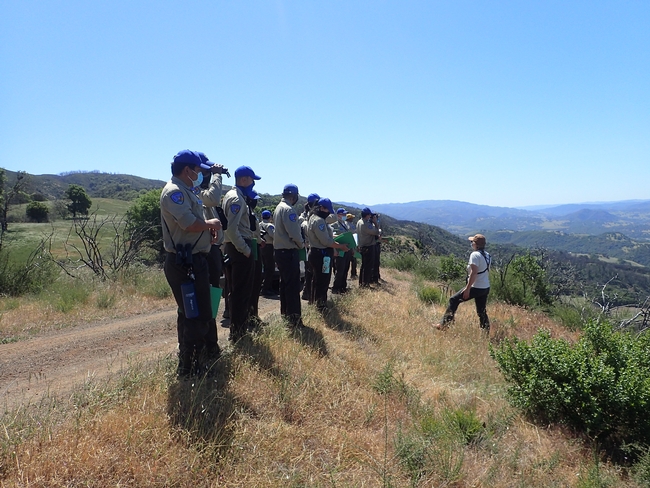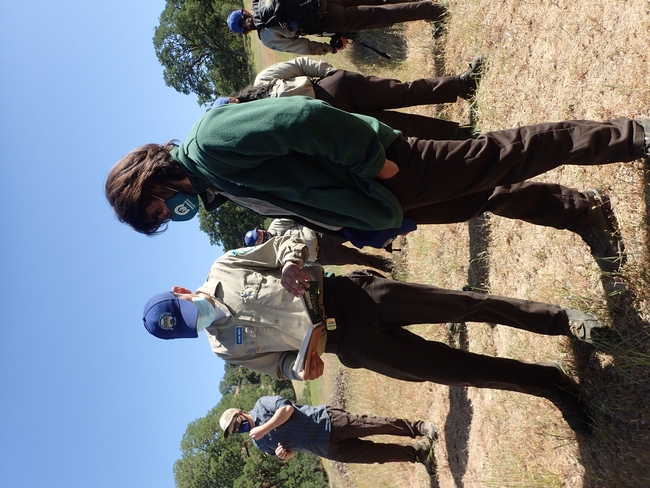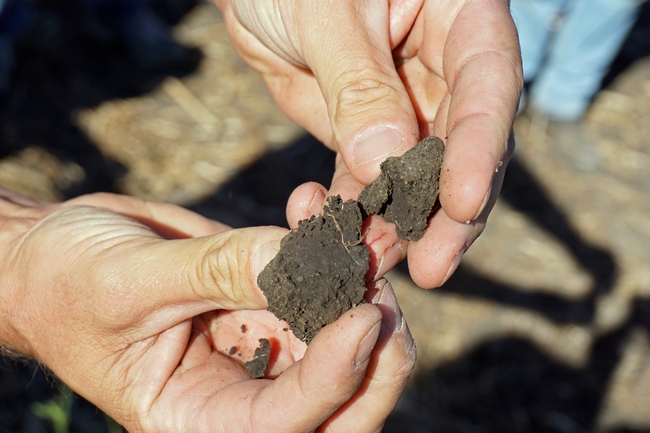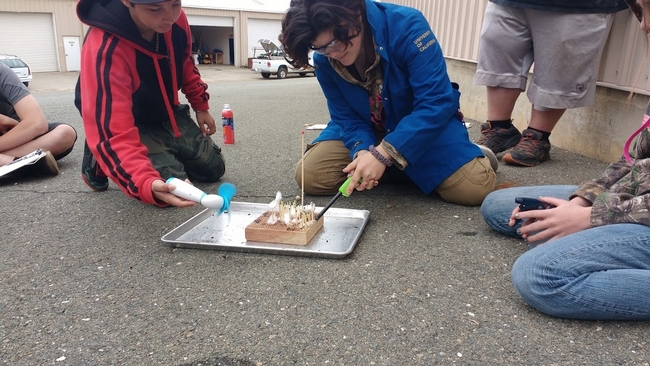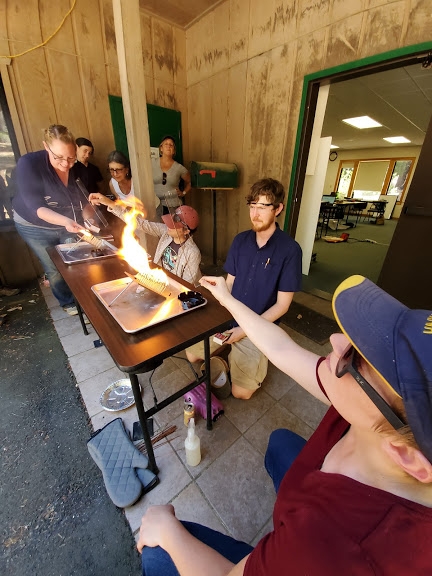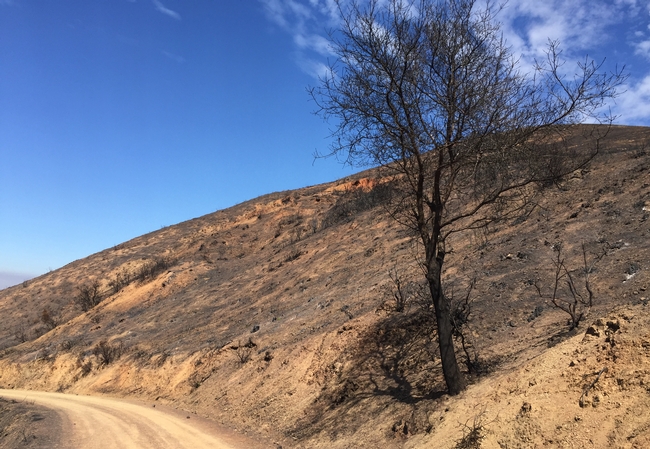Posts Tagged: Hopland
New wave of California Naturalists emerge from course at Hopland REC
Thirty-eight young, budding naturalists sit in a meadow while journaling and sketching their observations of the wildflowers and birds around them. They have come from various educational backgrounds to gather at the University of California Agriculture and Natural Resources' Hopland Research and Extension Center (REC) to learn about local natural ecosystems through a California Naturalist course.
Although they vary in expertise, these students share a common motivation: immerse themselves in the natural world and eventually teach others about its importance.
“The class really changed the way I view the world around me,” said Will Zuniga, a recent class participant at Hopland REC. “Now that I've taken it, I don't just see plants around me – I see stories. I understand more about the relationship that all of nature's moving parts have with each other. The class has given me more drive to learn about the world around me and to teach others as well.”
Under the UC ANR umbrella, the California Naturalist Program certifies participants through an immersive 40+ hour class delivered by one of its partner organizations, in this case, the California Conservation Corps (CCC). Aged 18 to 25 (and U.S. military veterans up to age 29) and from diverse educational backgrounds across the state, these California Naturalist students worked hard to fulfill the mission of the CCC – to protect and enhance California's natural resources and communities through education and service.
The California Naturalist Program promotes environmental literacy and stewardship through discovery and action. The program is designed to introduce Californians to the wonders of our unique ecology, engage the public in the study and stewardship of California's natural communities, and increase community and ecosystem resilience. Many other states have similar naturalist programs, but this is the first statewide program in California.
“California Naturalist training allows people of different backgrounds to come together to set what is the standard for how we talk about the sky, the ground below us, and the water that's flowing around us,” reflected Jacob Croasdale, a former class participant. “[They teach us] how to engage respectfully in a way that allows us to both receive and give back to nature.”
Although students graduate with broad knowledge of California's natural wonders, prior knowledge of the course's subject matter is unnecessary. “At first, I thought…I don't belong here. I'm just this artist - what do I have to offer?” shared Monique Wales, another former class participant. “There were Master Gardeners, geologists, biologists and people with crazy amounts of knowledge. But we all came together with such enthusiasm, and we wanted to learn from each other. It was such a fun group.”
“People who are thinking about the California Naturalist program but aren't sure that they know enough to step into something where the language is maybe more technical than they're familiar with should not be intimidated,” added Pete Devine, resident naturalist at Yosemite Conservancy. “A lot of participants are beginners and just generally interested folks. These people belong in the California Naturalist Program.”
A quick peek at the syllabus reveals many themes, field trips and interactions with local experts that culminate in the well-rounded knowledge necessary to help preserve our unique ecosystems. California has an incredibly diverse range of wildlife, habitats, rivers, lakes and coastal resources – wild and urban alike – and ecosystem and community resilience are essential.
After the course is completed, California Naturalists perform service through education and interpretation, stewardship, participatory science, environmental program support, community resilience and environmental justice. To date, certified California Naturalists, together with Climate Stewards (another component of the program), have volunteered more than 250,000 hours, worth over $7 million, in 52 of 58 counties in California.
The relationship between CCC and California Naturalist was piloted at the Hopland REC over the last two years and is now being rolled out across the state with support from the Prop 64 Youth Community Access fund. Overall, the project aims to offer three California Naturalist instructor trainings for 48 youth leaders, 24 California Naturalist certification courses for 480 Corps members, visits to or engagement with over 40 unique cultural and natural resources around the state each year, and 3,840 hours of service-learning outreach through youth-led video capstone projects promoting natural and cultural resources.
Overall (and most importantly), the California Naturalist Program allows corps members to have a solid connection to the “why” of their hard work.
Perhaps if we can all connect a bit more with nature in our backyard, we too will see the stories hidden in the plants, water, animals and land.
UC Cooperative Extension to investigate healthy soil practices with CDFA grants
Six UC Cooperative Extension research projects were awarded funding ranging from $100,000 to $250,000 each from the California Department of Food and Agriculture Healthy Soils Program. The grants are designed to fund implementation and demonstration of on-farm soil health practices that reduce greenhouse gas emissions and store carbon.
One of the grant recipients, John Bailey, director of the UC Hopland Research and Extension Center in Mendocino County, will use the $100,000 award to establish a perennial hedgerow at the center. Hedgerows are not traditionally part of standard ranching practices in Mendocino County, where in the past the center's 5,400 acres of rangeland and surrounding areas were grazed by large flocks of sheep.
“At Hopland, we have pivoted our operation to reflect the current state of the sheep industry in California, with reduced overall sheep numbers and decreased individual flock size, so we will use this project to show our smaller-scale sheep owners how they can enhance the ecosystems of their properties,” Bailey said.
Bailey expects the hedgerow to offer many educational, ecological and practical benefits, including enhancing soil health, increasing soil carbon sequestration, and providing habitat and food sources for beneficial organisms, such as pollinators and birds.
There may also be economic benefits to using sustainable practices in raising sheep. The project will explore the financial costs of implementing hedgerows as well as the opportunity for producers to enter a niche fiber market by offering sustainably produced wool to textile companies and consumers willing to pay a premium to support the ecological benefits of Healthy Soil Projects.
“I'm excited about this opportunity to combine the latest knowledge on environmental sustainability practices with the older traditions of livestock grazing in Northern California,” Bailey said. “This is a progressive step that ties in ecological knowledge that can benefit the livestock ranching model by both enhancing their properties and creating new markets for their products.”
The following projects were also funded by CDFA Healthy Soils Program in 2020:
Integrated sustainable nitrogen management in vegetable cropping systems, $250,000
Maria de la Fuente, UCCE county director and advisor, Monterey and Santa Cruz counties
The implementation of climate-smart agricultural practices within intensively managed vegetable cropping systems is extraordinarily challenging. Often conservation practices cannot be effectively implemented due to operational barriers, resulting in very low rates of adoption.
By demonstrating nutrient management strategies in partnership with a large influential vegetable grower in the Salinas Valley, the project aims to encourage broad scale practice adoption.
Recent research has indicated the addition of organic amendments in combination with nitrogen fertilizers potentially reduces nitrogen-derived greenhouse gas emissions and nitrate leaching while increasing soil carbon stocks. These outcomes will generate significant climate benefits in agroecosystems experiencing heavy tillage and fertilizer inputs.
This project has the potential for statewide impact as the researchers are currently working with the developers of COMET-Farm to provide data and coordinate outreach within vegetable cropping systems. Through direct engagement the team will make integrated sustainable nitrogen management more feasible and agronomically favorable for producers.
Using hands-on COMET-Farm-focused field days and a webcasted sustainable nitrogen short course, the project will provide producers with additional tools to make nutrient management planning decisions that have positive climate and soil health outcomes.
Evaluation of compost application to processing tomato fields in the Sacramento Valley, $100,000
Amber Vinchesi-Vahl, UCCE vegetable crops advisor, Colusa, Sutter and Yuba counties
The project will demonstrate compost applications on two farms in two Sacramento Valley counties, Colusa and Sutter. The researchers will work with Westside Spreading LLC and compare two plant-based compost rates to a control (no compost) over three years. Soil health parameters – such as total carbon and nitrogen, pH, EC, organic matter and fertility analyses relevant to tomato crop production – will be measured.
The benefits of compost applications vary depending on how often they are used, how much is applied, crop rotation, and other management decisions, such as whether compost is incorporated or left on the soil surface. Vinchesi-Vahl expects that over time the compost implementation evaluated in this project will result in lower input costs and improved soil function.
Compost application may reduce the need for fertilizer inputs for some of the rotational crops and provide benefits to the microbial community, thereby improving soil structure and reducing heavy conventional tillage needs.
By improving soil health, the research expects plant health will also be improved, leading to better tolerance to pest pressure from diseases and weed competition.
The two demonstration sites will showcase compost applications and their impact on processing tomato production and annual production soil health. These focused demonstrations will be extremely important in showcasing this soil health practice in the local Sacramento Valley region, providing information to growers from the experiences of collaborators at the two sites.
Evaluation of winter cover crop species for their ability to mitigate soil compaction in an annual rotation, $100,000
Sara Light, UCCE agronomy advisor, Sutter, Yuba and Colusa counties
This project has three components:
- Replicated research plots in which three cover crop varieties are evaluated for improvements in soil structure, specifically subsurface soil compaction
- Fieldscale demonstration plots in which varieties thought to reduce soil compaction are planted and visually assessed for performance in the Sacramento Valley
- Small, single-row hand planted plots in the buffer area, in which a wider number of both summer and winter cover crop varieties will be planted for outreach and demonstration purposes
Combined, these components will enable growers to make more informed decisions about cover crop selection and encourage wider adoption of cover cropping. The outreach objective for this project is to reduce barriers to cover crop adaption among regional growers by increasing knowledge and information about varietal selection and field-scale cover crop management, as well as opportunities to improve soil structure using cover crops.
Healthy soils demonstration project with Cardoza Farm, $100,000
Ruth Dahlquist-Willard, UCCE small farms advisor, Fresno and Tulare counties
This project will demonstrate compost application, hedgerow planting, and application of mulch generated from cover crop residue in a vineyard producing organic raisin grapes. Mulch will be applied directly under the vines, providing ground cover that will conserve soil moisture and decrease weed pressure. Generating the mulch on-farm eliminates the need to transport materials from outside sources.
Currently, production of organic raisin grapes involves frequent tillage under the vines. The cover crop between rows and the mulch under the vines will reduce the need for tillage for weed control and increase soil organic matter. These practices will be showcased at field days that will include bilingual training for small-scale, socially disadvantaged farmers in the San Joaquin Valley.
Application of compost to alfalfa to improve soil structure and fertility, $250,000
Kate Scow and Radomir Schmidt, UC Davis Department Land, Air, Water Resources and UCCE advisors Michelle Leinfelder-Miles and Rachael Long
This project will demonstrate compost application to alfalfa for improving soil structure and fertility. Compost is not typically applied to alfalfa; however, manure application to alfalfa is common in the state's dairy regions.
The over half a million acres of alfalfa in California could represent an important repository for compost, for which a large land base of spreading may be needed as municipalities convert organic waste management streams to diversion from landfills.
Alfalfa has the ability to immobilize large amounts of nitrogen and phosphorus, nutrients of concern in the concentration of organic wastes due to their potential to contribute to water pollution. Furthermore, alfalfa growers are interested in the potential of compost to improve soil structure in their alfalfa fields, as many growers report suffering from the large cracks that form in soils during the wet-dry cycles of alfalfa surface irrigation management.
Compost application has been anecdotally reported to alleviate soil cracking in another perennial crop, almond orchards in the Central Valley, but soil structure improvement via management practices like compost application has received little research attention thus far. Westside Spreading LLC is collaborating on this project.
To prepare Californians for wildfire in oak woodlands, UC ANR offers teachers training
California's most destructive wildfire year on record was 2018, with devastating fires occurring in Northern California oak woodlands. From 2015 to 2017, six of California's 20 most deadly and destructive fires in history occurred in these areas. The communities living in oak woodlands, which had been mostly spared from previous wildfires, were largely unprepared.
To prepare Californians to live with wildfire, Kate Wilkin, former UC Cooperative Extension forestry/fire science and natural resources advisor, and UC Sierra Foothill Research and Extension Center and Hopland Research and Extension Center community educators Alexandra Stefancich and Hannah Bird received a $100,000 Environmental Protection Agency Environmental Education grant.
In addition to delivering community workshops, the educators will offer online training for teachers this summer. The curriculum will be introduced by webinar on Tuesday, July 14, from 11 a.m. to 11:30 a.m. (PDT). Register online for this free webinar at https://bit.ly/firecurriculum.
“The goal of this project is to educate youth and adults about their natural ecosystems and how to reduce the risk of catastrophic wildfire,” Stefancich said.
Even before the current COVID-19 pandemic constrained activities, challenges arose: the federal government shutdown delayed the grant; a wildfire burned approximately two-thirds of the Hopland REC; Wilkin moved on from UCCE and Rebecca Ozeran, UCCE livestock and natural resources advisor, took over leading the wildfire education project.
Training kids, adults and communities
The team is educating children, adults and communities. Their three-pronged approach includes youth education for 500 middle school students and training for teachers; adult education through advanced training for California Naturalists; and community education by partnering with Fire Safe Councils in Butte, Mendocino and Yuba counties.
“One of the most exciting aspects of this grant has been the youth fire education component,” Bird said. “The grant has funded an adaptation of theUS Forest Service's FireWorks Curriculum – first modeled for Rocky Mountains forests – to the California oak woodland ecosystem. This hands-on, place-based science curriculum aims to provide students an in-depth understanding of fire science. In working on this curriculum, the team wants to highlight the importance of not only oak woodland fire science, but the cultural history associated with fire on these landscapes.”
The grant allowed the team to work with local representatives from the Hopland Band of Pomo Indians, Kashia Band of Pomo Indians, United Auburn Indian Community and the Nevada City Rancheria to develop lessons shaped by the cultural value of fire as a tool and the long relationship between people and fire in California.
While developing the lessons, the team realized the importance of trauma-informed educational practices.
“Just five years ago, we often talked about wildfire theoretically, but now every student I speak with has their own experience to share,” Bird said. “It is important to give time in the lessons for the trauma experienced by our youth, and to educate them and encourage a sense of agency. These lessons focus on the positive! We don't spend time on things that we cannot change. We learn crucial concepts of fire science and build on them to make our schools, families and communities more fire prepared.”
Feelings about fire
The team piloted the new curriculum with more than 150 middle school students in Redwood Valley and Ukiah, just before schools closed due to the COVID-19 pandemic.
“Trialing the curriculum with students was really valuable,” Bird said. “These students have seen their communities affected by wildfire and it brings up many emotions for them.”
Students were asked to share their thoughts around fire at the beginning of the lessons and again at the end of the lesson series. Feelings of fear were replaced with feeling prepared and confident.
Before the lessons, students' comments about fire included, “Scary because I live in the mountains and my house is there, it could burn down.”
After the lessons, their comments included, “I felt positive about this, I feel that I know what to do, I think everyone should know how to prepare for fire.”
Pomolita Middle School students made an action plan for their school to help improve school fire preparedness. Students had hoped to present their plans to school administrators, but school closures due to the coronavirus crisis have delayed the presentation.
“Most of what we found at Pomolita school was really positive – the students do have a few suggestions that they hoped to share with the school administration,” Bird said. “Students also made an emergency contact plan and planned what they would like to have in a go bag for themselves and for their pets.”
Community educator Stefancich added, “This curriculum, aimed at middle school students, is ideal for any educator hoping to provide their students with more insight about the role fire plays in the ecosystem and how they can prepare for its eventuality. Each lesson is set up for the lay educator to be able to teach, so even without advanced fire knowledge it will be easy to use.”
The team continues to adapt the FireWorks curriculum for oak woodlands and expects it to be available at the FireWorks site https://www.frames.gov/fireworks/curriculum/overview by the fall.
Coming Oct. 7: A Tour of Kate Frey's Bee-utiful Garden
"When's the next public tour of Kate Frey's garden?" That's a question we're often asked and now we have an answer: Saturday, Oct. 7. World-class...
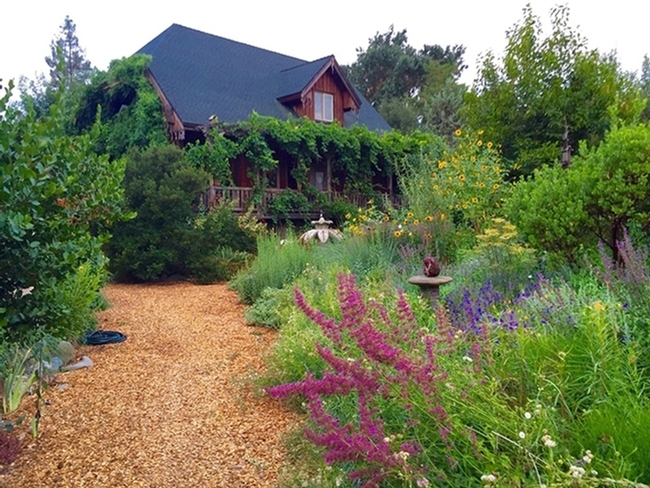
This is the Hopland home of Kate and Ben Frey, featuring gardens by Kate and rustic structures and whimsical art by Ben. (Photo by Kate Frey)
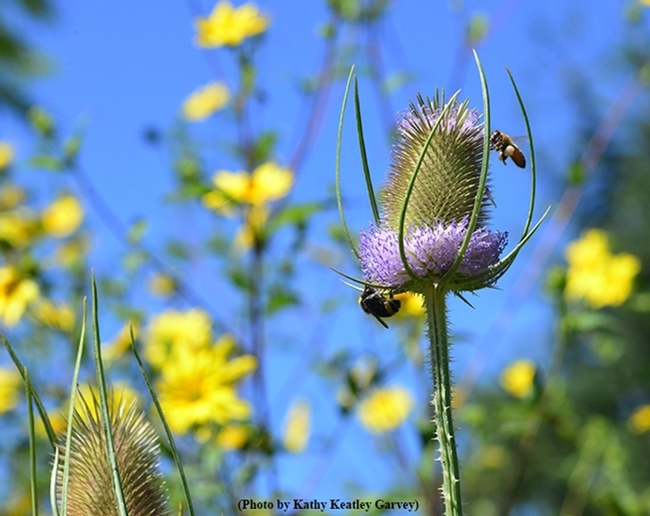
A bumble bee and honey bee share teasel in the Frey gardens. (Photo by Kathy Keatley Garvey)
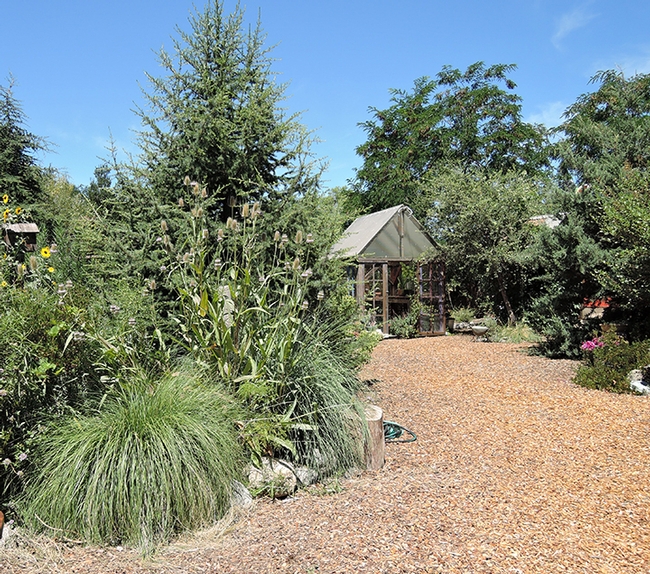
An inviting path in the Frey gardens. (Photo by Kathy Keatley Garvey)
Bee-ing All You Can Be and See and Do
What a weekend for bee and gardening enthusiasts! It's a shame we all can't clone ourselves and be in two places at the same time! The 40th annual...
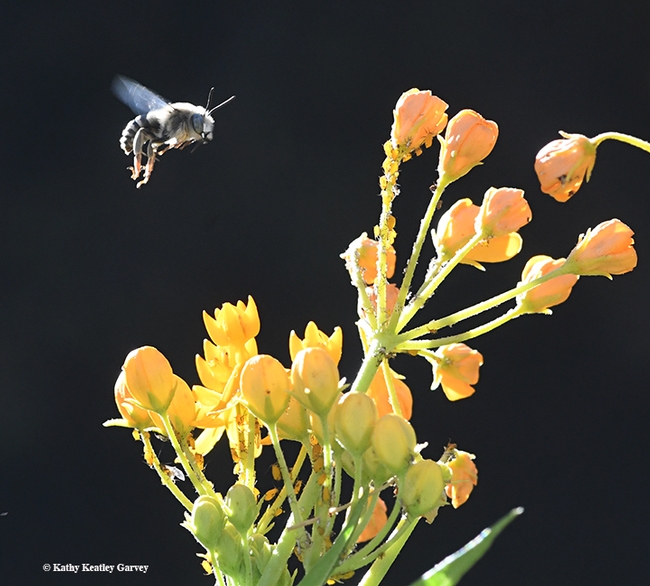
A native bee, Anthophora urbana, buzzes over a tropical milkweed. (Photo by Kathy Keatley Garvey)


